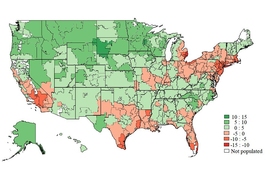The new health care practice of “hotspotting” — in which providers identify very high-cost patients and attempt to reduce their medical spending while improving care — has virtually no impact on patient outcomes, according to a new study led by MIT economists.
The finding underscores the challenge of reducing spending on “superutilizers” of health care, the roughly 5 percent of patients in the U.S. who account for half the nation’s health care costs. The concept of hotspotting, a little more than a decade old, consists of programs that give at-risk patients sustained contact with doctors, other caregivers, and social service providers, in an attempt to prevent rehospitalizations and other intensive, expensive forms of care.
The MIT study was developed in cooperation with the Camden Coalition of Healthcare Providers, which runs one of the nation’s best-known hotspotting programs. The researchers conducted a four-year analysis of the program and found that being enrolled in it makes no significant difference to patients’ health care use.
“This intervention had no impact in reducing hospital readmissions,” says Amy Finkelstein, an MIT health care economist who led the study.
Significantly, the new study was a randomized, controlled trial, in which two otherwise similar groups of patients in Camden were separated by one large factor: Some were randomly selected to be part of the hotspotting program, and an equal number of randomly selected patients were not. The two groups generated virtually the same results over time.
“The reason it was so important we did a randomized, controlled trial,” Finkelstein says, “is that if you just look at the individuals in the intervention group, it would look like the program caused a huge reduction in readmissions. But when you look at the individuals in the control group — who were eligible for the program but were not randomly selected to get it — you see the exact same pattern.”
The paper, “Health Care Hotspotting — A Randomized, Controlled Trial” is being published today in the New England Journal of Medicine. The co-authors are Finkelstein, the John and Jennie S. MacDonald Professor Economics at MIT, who is the paper’s corresponding author; Joseph Doyle, an economist who is the Erwin H. Schell Professor of Management at the MIT Sloan School of Management; Sarah Taubman, a research scientist at J-PAL North America, part of MIT’s Abdul Latif Jameel Poverty Action Lab; and Annetta Zhou, a postdoc at the National Bureau of Economic Research.
Camden Coalition “fabulous partners” in seeking answers
To conduct the study, the MIT-led research team evaluated 800 patients enrolled in the Camden Coalition of Healthcare Providers program from 2014 to 2017. The patients in the study had been hospitalized at least once in the six months prior to admission and had at least two chronic medical conditions, among other health care issues. The study was constructed after extensive consultation with the coalition.
“They were fabulous partners,” Finkelstein says about the coalition. “Because they’re so data-driven, they had the data infrastructure in place, which made this possible.”
Finkelstein particularly cites the founder of the Camden Coalition of Healthcare Providers, Jeffrey Brenner, who served as executive director of the organization from 2006 through 2017, and whose development of “hotspotting” concepts has received substantial public attention. In Camden, where 2 percent of patients represent 33 percent of medical expenses, preventing the need for acute care is a pressing concern.
“Dr. Brenner is a really extraordinary person, and he’s trying to solve a very hard problem,” Finkelstein says, crediting Brenner for actively seeking data about his organization’s results without knowing what those outcome would be.
Half of the study’s 800 patients were placed in a group that used the program’s services, and half were in a control group that did not take part in the program. The Camden hotspotting program includes extensive home care visits, coordinated follow-up care, and medical monitoring — all designed to help stabilize the health of patients after hospitalization. It also helps patients apply for social services and behavioral health programs.
Overall, the study found that the 180-day hospital readmission rate was 62.3 percent for people in the program and 61.7 percent for people not in the program.
Additional measurements in the study — such as the number of hospital readmissions for patients, aggregate number of days spent in the hospital, and multiple financial statistics — also showed very similar outcomes between the two groups.
The study shows that while the overall number of people in hotspotting programs who need rehospitalization declines over the course of the program, it does not decline by a larger amount than it would if those people were outside the program’s reach.
In short, people in hotspotting programs require fewer rehospitalizations because any group of patients currently using a lot of health care resources will tend to have lower health care use in the future. Previous reports about hotspotting programs had focused on the roughly 40 percent decline in six-month hospital readmissions — while not comparing that to the rate for comparable patient groups outside such programs.
“If you think about health care interventions, almost by definition they’re occurring at a time of unusually poor health or unusually high cost,” Finkelstein says. “That’s why you’re intervening. So they’re almost by construction going to be plagued by the issue of regression to[ward] the mean. I think that’s a really important lesson as we continue to try to figure out how to improve health care delivery, especially as so much of the work focuses on these high-cost patients.”
“We’re not going to give up”
To be sure, as Finkelstein notes, the new study is a local one, and hotspotting programs exist in many locations. It also examines the four-year results of the program, which underwent some evolution during the study period; if the program had made a breakthrough change in, say, 2016, that would only partially be reflected in the four-year data. As it happens, however, the study found no such large changes over time.
Brenner’s perspective about studying the effectiveness of his own initiative, Finkelstein says, was that, by analogy, “if you have a new medication to try to cure cancer, and you run a clinical trial on it and it doesn’t work, you don’t just say, ‘I guess that’s it, we’re stuck with cancer.’ You keep trying other things. … We’re not going to give up on improving the efficiency of health care delivery and the well-being of this incredibly under-served population. We need to continue to develop potential solutions and rigorously evaluate them.”
Finkelstein also notes that the current study is just one piece of research in the complicated area of improving health care and reducing costs for people in need of extensive treatment, and says she welcomes additional research in this area.
“I hope it inspires more research and that more organizations will partner with us to study [these issues],” Finkelstein says.
Finkelstein also serves as the scientific director of J-PAL North America at MIT, which backs randomized controlled trials on a variety of social issues.
The data for the study came from the Camden Coalition of Healthcare Providers; Camden’s four hospitals; and the state of New Jersey.
The research was supported by the National Institute on Aging of the National Institutes of Health; the Health Care Delivery Initiative of J-PAL North America; and the MIT Sloan School of Management.




![“Contrary to the conjecture that Medicaid would get people to [move] out of the emergency room and to the primary care physician, we’re seeing a persistent increase in emergency room use,” says Amy Finkelstein, the John and Jennie S. MacDonald Professor of Economics at MIT.](/sites/default/files/styles/news_article__archive/public/images/201610/MIT-amy-finkelstein.jpg?itok=HeXLwtW1)






